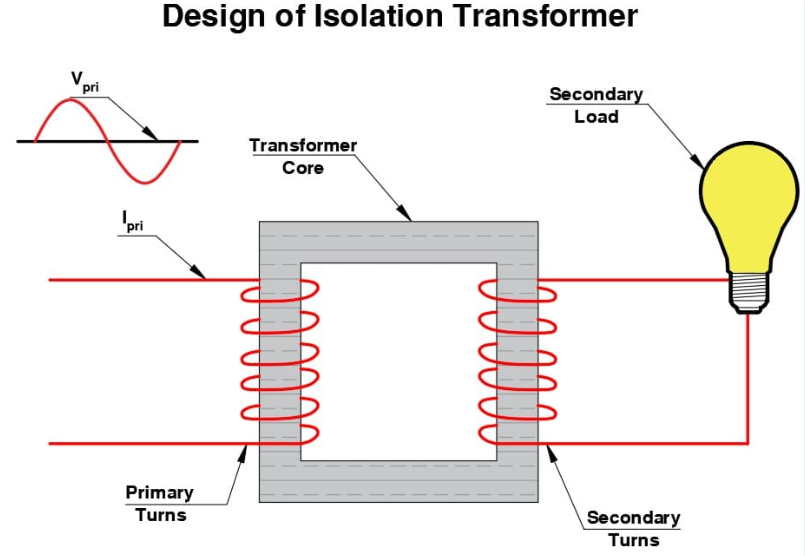An isolation transformer is a crucial component in electrical engineering that plays a fundamental role in maintaining safety, providing galvanic isolation, and preventing electrical disturbances. It serves as a vital tool in various industries, ensuring the protection of equipment, personnel, and sensitive electronic devices. Let’s delve deeper into the intricate workings, significance, applications, and benefits of isolation transformers in a comprehensive exploration.

Understanding Isolation Transformers
An isolation transformer is a device that electrically isolates two separate parts of an electrical system while allowing the transfer of power between them. It consists of two coils of wire, the primary and secondary windings, wound around a shared iron core. Unlike other transformers that may step up or step down voltage, the primary purpose of an isolation transformer is not to change the voltage level but to provide electrical isolation.
Principles of Operation
The principle behind an isolation transformer is based on electromagnetic induction. When an alternating current (AC) flows through the primary winding, it creates a varying magnetic field in the iron core. This changing magnetic field induces an AC voltage in the secondary winding, generating electricity without a direct electrical connection between the primary and secondary circuits. As a result, it isolates the output from the input electrically, preventing the transfer of DC current and high-frequency noise.
Importance of Isolation
Isolation transformers are paramount in various applications where electrical safety and interference-free power are critical. They are extensively used in medical equipment, telecommunications, data centers, industrial machinery, and audio systems. In medical settings, such transformers ensure patient safety by preventing ground loops and electrical noise, while in audio systems, they eliminate humming and buzzing sounds caused by ground loops or interference.
Safety Measures and Protection
One of the primary reasons for using isolation transformers is to enhance safety. They protect against electric shocks and reduce the risk of short circuits by providing isolation between the input and output circuits. In scenarios where equipment needs to be grounded for safety reasons but electrical noise or ground loops are undesirable, isolation transformers prove indispensable. Additionally, they safeguard sensitive electronic equipment from voltage spikes and surges, thereby prolonging their lifespan and ensuring uninterrupted operation.
Applications in Various Industries
Medical Industry
Isolation transformers are extensively employed in medical equipment such as MRI machines, X-ray machines, and patient monitoring systems. They prevent electrical interference and ensure the safety of both medical professionals and patients by isolating the power supply.
Telecommunications
In the telecommunications sector, especially in data centers and communication networks, isolation transformers play a crucial role in maintaining signal integrity and preventing disruptions caused by electrical noise and ground loops.
Industrial Machinery
Various industrial machines, especially those involving sensitive electronics, rely on isolation transformers to protect against power surges and maintain consistent power quality. CNC machines, robotics, and automated systems benefit from the stable and clean power provided by isolation transformers.
Audio Systems
High-end audio systems and recording studios use isolation transformers to eliminate ground loops and reduce interference, ensuring a clean and clear sound output.
Benefits of Isolation Transformers
Electrical Safety: Protects against electric shocks and short circuits, ensuring safety in various applications.
Equipment Protection: Guards sensitive electronic equipment against voltage spikes and surges, extending their lifespan.
Reduction of Noise and Interference: Minimizes electrical noise, ground loops, and interference, providing clean power for accurate signal transmission.
Signal Integrity: Preserves signal integrity in telecommunications, audio systems, and sensitive electronic devices.
Compatibility: Ensures compatibility between different types of equipment by eliminating potential electrical issues.
Types of Isolation Transformers
Isolation transformers come in various types, catering to different voltage levels, power capacities, and applications. Some common types include:
Single-phase Isolation Transformers: Used in residential and small-scale commercial applications.
Three-phase Isolation Transformers: Suited for industrial and heavy-duty commercial applications.
Auto-transformers: Provide voltage transformation along with isolation, although to a lesser extent than traditional isolation transformers.
Conclusion
In conclusion, isolation transformers are indispensable components in electrical systems, ensuring safety, protecting equipment, and maintaining signal integrity across various industries. Their ability to electrically isolate circuits while allowing power transfer has made them an essential tool in ensuring reliable and safe electrical operations. From medical equipment to industrial machinery and telecommunications, the importance of isolation transformers cannot be overstated in the modern world’s reliance on technology and electronics. Their role in providing clean and isolated power remains paramount for the smooth functioning of countless applications and systems, ultimately contributing to enhanced safety and operational efficiency.
